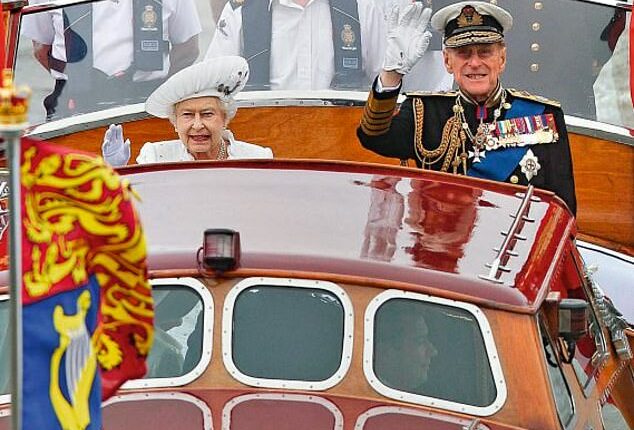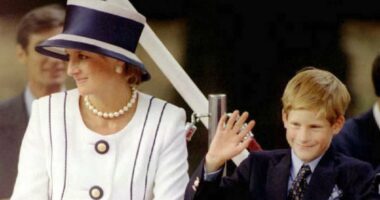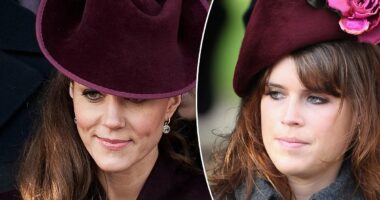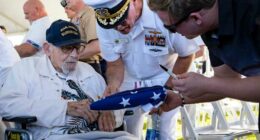Share this @internewscast.com
Prince Philip ended up in hospital after he refused to sit down during Queen Elizabeth II’s Diamond Jubilee celebrations due to fears he would look like ‘Mr Beckham’, a royal author has revealed.
For many Brits in the 2000s and 2010s, there wasn’t a couple more idolised than David and Victoria Beckham.
Posh and Becks’ hairstyles and fashion choices were emulated by millions across the country.
However, the then-90-year-old Duke of Edinburgh in 2012 inflamed an existing health condition when he risked not copying David.
Writing in his biography about Prince Philip, titled Philip: The Final Portrait, broadcaster and royal author Gyles Brandreth wrote that the Duke chose to stand for the entirety of the late Queen’s Diamond Jubilee River Pageant rather than sit on a ‘grandiose throne’.
‘On Monday, 4 June, 2012, six days before his [Prince Philip’s] 91st birthday, he [Philip] should have been at the Queen’s side at the Diamond Jubilee concert that was staged in her honour in front of Buckingham Palace.
‘He wasn’t there because the day before he had stood at the Queen’s side in a boat on the Thames in driving rain and had exacerbated a pre-existing bladder infection,’ Brandreth said.
He claims that both Philip and Elizabeth remained standing for the entirety of the 7.5 mile journey down the River Thames rather than sitting down on the thrones provided by the organisers.

Queen Elizabeth II and Prince Philip wave to onlookers during a pageant in celebration of the Queen’s Diamond Jubilee along the River Thames in June 2012. Philip ended up in hospital after he refused to sit down during Queen Elizabeth II’s Diamond Jubilee celebrations due to fears he would look like ‘Mr Beckham’

David and Victoria Beckham in 2025. For many Brits in the 2000s and 2010s there wasn’t a couple more idolised than David and Victoria Beckham. Posh and Becks’ hairstyles and fashion choices were emulated by millions across the country

Both Philip and Elizabeth remained standing for the entirety of the 7.5 mile journey down the River Thames rather than sitting down on the thrones provided
Brandreth wrote that Philip made the decision because if the husband and wife had sat down they would have ‘looked like Mr and Mrs Beckham’.
The comment was in reference to the couple’s 1999 wedding which saw David and Victoria sit in red throne chairs reminiscent of those on the royal barge.
‘And because the Queen remained on deck, standing in the rain, the Duke remained there, too. It would not have occurred to him to have been anywhere else,’ Brandreth said.
Philip was then admitted to hospital the following day – meaning he missed the concert that evening where his son, Charles, gave a short speech praising his mother and thanking those who had performed.
The loudest cheer from the jubilant crowd was reserved for Prince Philip when Charles name-dropped the absent Duke.
The crowd then started chanting ‘Philip, Philip, Philip’ in a showcase of their affection for the Prince.
‘A mile away, in his hospital bed, the Duke of Edinburgh watched the scene on television – and was touched by what he saw and heard,’ Brandreth wrote.
Indeed, the public’s love for Prince Philip was well documented throughout his decades of public service.

The red throne chairs at David and Victoria Beckham’s wedding which were reminiscent of the ones on the royal barge during the Diamond Jubilee celebrations

Gyles Brandreth wrote that Philip made the decision because not to sit down because if the husband and wife had they would have ‘looked like Mr and Mrs Beckham’
This was despite his notorious gaffes which could often land Philip in hot water.
In 2015, an impatient Prince Philip appeared to say: ‘Just take the f****** picture’ during a photocall for the Battle of Britain.
In the clip, he repeatedly said ‘just take it’ and gesturing before dropping the f-word, after which laughter is heard and the photo is hastily snapped.
His other gaffes included telling a driving instructor in Scotland during a 1995 walkabout: ‘How do you keep the natives off the booze long enough to get them through the test?’ and asking legendary Welsh singer Tom Jones if he gargled with pebbles after his 1969 Royal Variety Performance.
His most controversial gaffe came in 1986 when he told a British student in China during his only state visit to the country that ‘if you stay here much longer you’ll be slitty-eyed’.
The comment provoked accusations of racism in the British Press and caused tension between the UK and China who enjoyed a warming of relations at the time following their joint agreement on the handover of Hong Kong.
Despite his gaffes, Philip was a valued member of the Royal Family who was all too familiar with the sacrifices involved with joining the Firm.

Prince Philip laughs while talking to his son – Prince Charles – during the late Queen’s Diamond Jubilee celebrations. Philip was then admitted to hospital the following day meaning he missed the concert at Buckingham Palace

Philip after he was discharged from hospital. The Duke watched the concert from his hospital bed and was reportedly touched by the public show of support for him
After becoming the Duke of Edinburgh, Philip gave up his birth citizenship, his naval career and even his surname. In many ways he accepted that his life would be spent in the shadow of Queen Elizabeth II.
Even before Philip married Elizabeth and became the Duke of Edinburgh, he had to renounce his Greek and Danish citizenship in order to become a naturalised Brit.
He also changed his name from Philippos Andreou of Schleswig-Holstein-Sonderburg-Glücksburg to Mountbatten.
Philip experienced further turbulence once Elizabeth unexpectedly ascended to the throne at just 25 years of age following the sudden death of King George VI.
The Duke had to leave behind his successful career in the Royal Navy to take up new duties as the consort to the Queen.
Writing in her biography of their marriage – titled Elizabeth & Philip – Tessa Dunlop noted that Philip said he would not receive the title of Prince Consort that Albert was given, appreciating that ‘times had changed’.
Philip was less understanding of the proposed plan for the Queen to break royal tradition and retain Windsor as the name of the royal house. He wished her to take on his surname, but Prime Minister Winston Churchill, under the behest of Elizabeth’s grandmother Queen Mary, insisted that Windsor must stay.

Despite his gaffes, Philip was a valued member of the Royal Family who was all to familiar with the sacrifices involved with joining the Firm
A compromise was sought where, rather than taking on the Mountbatten name, the family could become known as the House of Edinburgh. ‘Philip wasn’t fussed over which name, so long as it was his name,’ Dunlop wrote.
But his wish was not granted and Windsor remained the family name.
According to Brandreth, Philip was left vexed by the decision and claimed he was ‘the only man in the country not allowed to give his name to his own children’.
Philip soon got over the surname debacle and committed himself to serving the country and his wife.
The Duke was patron of 800 organisations including, most famously, the Duke of Edinburgh award scheme.
Upon his retirement from royal duties on August 2, 2017, Philip had already become the longest-serving British royal consort, having spent more than 70 years by the Queen’s side.
His dedication to the Crown and his wife did not go unnoticed. In Elizabeth’s speech to mark her Diamond Jubilee in 2012 she paid tribute to Philip, describing him as her ‘constant strength and guide’.








